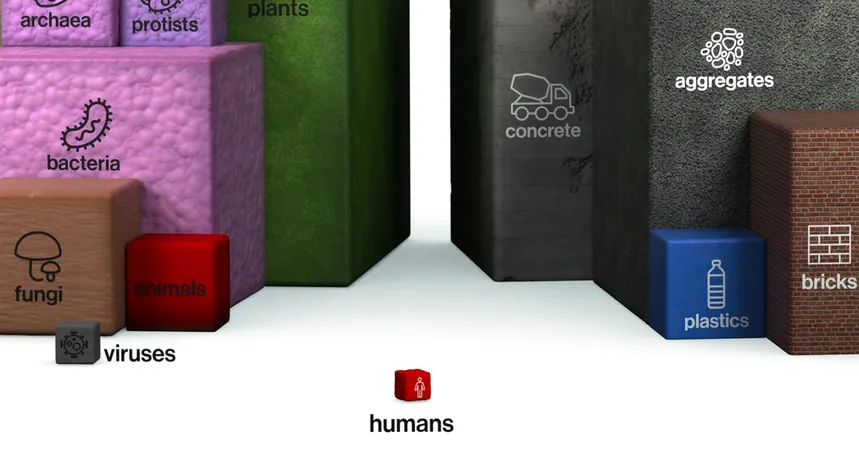
Shocking Visuals Reveal a Century of Human Waste: Are We Outweighing Nature?
2024-12-27
Author: Ting
Introduction: The Weight of Our Impact
In a stunning revelation about our planet, new research has illustrated how human activity has led to an overwhelming accumulation of man-made materials that now outweigh Earth's entire biomass. This eye-opening statistic is the result of extensive work by geophysicist Yinon M. Bar-On and his team, who compiled a comprehensive inventory of all living and non-living materials on Earth. While nature took billions of years to develop complex ecosystems, humans have radically reshaped the planet in just over a century.
The Unbelievable Numbers Behind Our Waste
The 2018 study posits that there are approximately 1.3 trillion tons of human-made materials currently on Earth, a staggering figure that breaks down into components such as concrete (600 billion tons), asphalt (70 billion tons), and a massive amount of sand used in construction. To put this into perspective, humans have produced enough materials to construct two billion cars—a testament to our relentless consumption and production.
Visualizing Our Planet: The Eye-Opening Graphics
Recently, physicist Brice Ménard and computer scientist Nikita Shtarkman transformed Bar-On’s research into an engaging visualization, represented by cubes. Each cube corresponds in size to the total weight of various materials, allowing viewers to see firsthand the enormous scale of human-produced items compared to natural biomass. Dr. Ménard emphasized, “This is the portrait of our planet,” calling attention to our startling impact during a relatively short period.
A Wake-Up Call: What This Means for Wildlife and the Earth
One shocking takeaway from this visual representation is that the biomass of humans compared to wild animals is disproportionate—humans outweigh wild animals 10 to 1, while we are outmatched by livestock populations that we raise for food. What’s perhaps more alarming is the fact that, on average, individuals use 100 times more plastic than their own body weight. This ratio is a glaring reminder of the environmental footprint that we each carry.
Conclusion: A Call to Action
These findings are more than mere statistics; they illuminate the pressing need for a shift in how we consume and produce. “I knew the numbers,” Dr. Ménard said of his realizations regarding plastic usage. “But witnessing this visually made me acutely aware of my plastic footprint and the urgency to reduce it.” As we navigate the complexities of modern living, it’s imperative for every individual to rethink their consumption patterns and strive for sustainability. This powerful visualization is not just a scientific exercise but a clarion call for global awareness and change. As aware stewards of our planet, we need to take tangible steps to ensure we do not tip the scales irreversibly in favor of waste over wildlife.


 Brasil (PT)
Brasil (PT)
 Canada (EN)
Canada (EN)
 Chile (ES)
Chile (ES)
 Česko (CS)
Česko (CS)
 대한민국 (KO)
대한민국 (KO)
 España (ES)
España (ES)
 France (FR)
France (FR)
 Hong Kong (EN)
Hong Kong (EN)
 Italia (IT)
Italia (IT)
 日本 (JA)
日本 (JA)
 Magyarország (HU)
Magyarország (HU)
 Norge (NO)
Norge (NO)
 Polska (PL)
Polska (PL)
 Schweiz (DE)
Schweiz (DE)
 Singapore (EN)
Singapore (EN)
 Sverige (SV)
Sverige (SV)
 Suomi (FI)
Suomi (FI)
 Türkiye (TR)
Türkiye (TR)
 الإمارات العربية المتحدة (AR)
الإمارات العربية المتحدة (AR)